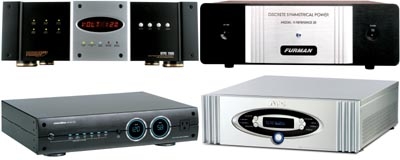POWERHOUSE Page 2

Power to Spare Since power-line noise and voltage fluctuations have been around for years, you might be wondering why they're suddenly such a big deal. The main reason is that today's gear uses things like surface-mount power supplies, microprocessors, and other miniature components that are more susceptible to damage by surges and spikes.
A surge protector - generally referred to now as a transient voltage surge suppressor, or TVSS - is designed to stop surges and spikes from reaching your gear, while a line conditioner is meant to reduce or eliminate noise and "dirt" in AC power lines. An uninterruptible power supply (UPS) is a battery-powered AC generator that provides enough time (usually 7 to 10 minutes) during a sudden power loss to let you do things like save system presets or let the fan cool your projector's lamp before you have to power down. Most line conditioners and UPS devices also provide surge protection, and some boast voltage regulation to ensure a steady stream of exactly-120-volt power.
Surge suppressors vary widely in both price and performance, but most work by absorbing transient voltage surges or by diverting them to the outlet's ground. The most common way to do this is to place one or more metal-oxide varistors (MOVs) between the "hot" power line and the ground. When the excess voltage hits a preset limit - typically 250 or 300 volts - the MOV's resistance drops, allowing the voltage to travel across the "hot" wire and into the ground. Less frequently used suppression options include silicon-avalanche diodes (SADs), which also clamp excessive voltage, and gas-discharge arrestors, which become conductive when the voltage surges above a certain level, passing the excess juice to the ground.
Some better surge protectors use a combination of SADs and MOVs, relying on the SADs' quick response and the MOVs' high-current capability. These suppressors often also have fuses that blow if the voltage gets too high. How much energy a MOV can withstand before it's destroyed or blows a fuse is measured in joules (see "Joules and Warranties").
While you can buy a basic surge protector at Home Depot for less than $30, chances are you'll wind up with little more than an outlet strip. Expect to pay between $100 and $300 for a minimum of real protection and upwards of $1,000 for state-of-the-art models featuring things like advanced line conditioning, multistage surge protection, and even voltage regulation.
Surge protectors have been available for years, but line conditioners are a relatively recent phenomenon. Most low-cost power conditioners use a filter to reduce AC-line noise, typically a capacitor plus a coil of magnetic material - sometimes called a toroidal choke coil - that spirals around the live wire, basically creating a band-pass filter. These simple filters are claimed to be effective at reducing high-frequency noise. Other, more sophisticated - and expensive - approaches include using an isolation transformer or even an AC regenerator, which converts AC power to much cleaner DC, and then back to AC. Cleaner AC power is said to improve both video (better black levels, brighter colors, and sharper details) and audio (richer sound and more detail) in some systems.
Uninterruptible power supplies have backed up personal computers for years, but it's only recently that home theater owners have turned to them for protecting their gear from power outages. Basically, all UPS devices contain a battery and an inverter, which converts DC power to 120-volt, 60-cycle AC power. Some UPS devices only use the battery when the need arises, while others run off the battery continuously. Most do line filtering and can protect your gear against surges, spikes, sags, and dips.
To hear some people, you'd think that a line conditioner can have more of an impact on your system's sound than your speakers. But as with all things audio and video, power products are an area where common sense should prevail, and the law of diminishing returns definitely applies. So do your research, check out some demos, and buy the product that will best protect your A/V investment. But remember: even a lowly $100 surge protector can help keep your prized system from becoming toast.




























































